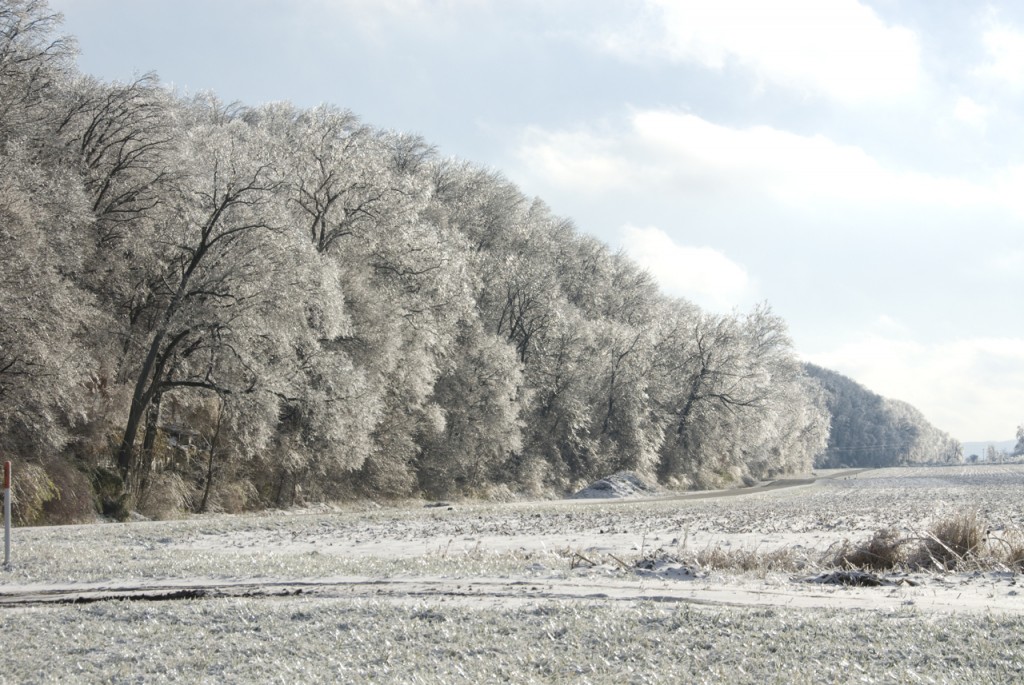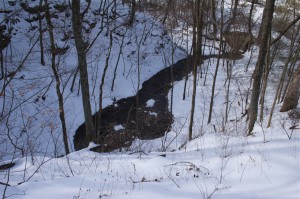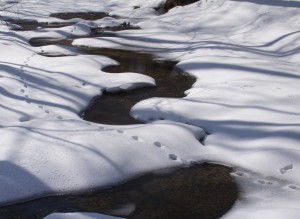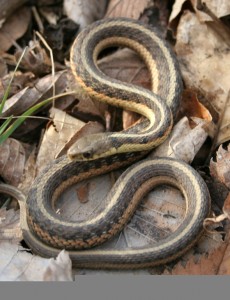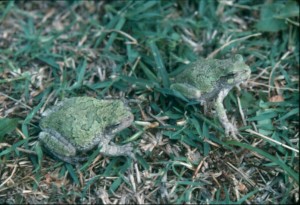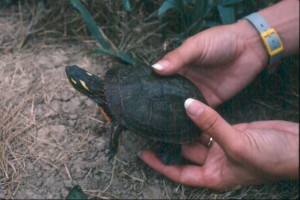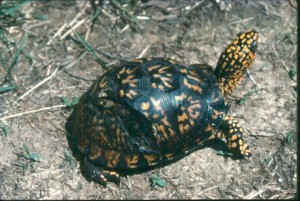Winter Hibernation: Living Through the Cold
Our bluff lands, in winter, take on a stripped-down, emptied-out aspect. The trees, now shorn of all but the most stubbornly clinging dried remnants of last-year’s lush growth, stand as mute skeletons to the winter winds. Most birds, no longer defending breeding territories with loud song, offer only soft location calls as they forage for insect larvae and eggs along with dried fruits and seeds. The occasional loud and cheering call of a Carolina Wren or the near-hysterically laughing sound of a Pileated Woodpecker sometimes break the quiet but, as the sounds fade, seem to even more deeply punctuate the winter stillness.
The question winter poses to wildlife (and, perhaps, to a few vacation-bound locals!) is a choice between stoically facing the difficulties of winter or migrating away to warmth. For those that remain, winter survival strategies vary.
Just as we pull on warm clothing, many mammals grow heavy winter coats. Even some birds do the same, increasing both the number and thickness of their feathers. Birds also fluff up their feathers adding air insulation to help them keep warm. Heavier outerwear, however, isn’t sufficient for active wildlife in the winter. For wildlife, food equals fat equals warmth equals survival. Many animals strive throughout the fall to add fat layers because the extra tissue acts as both an insulation layer protecting the animal from cold and as a source of energy to be drawn upon when food is scarce. A fat-laden bird is faced with a distinct difficulty — how to stay light enough to fly in search of more food as well as to quickly flee a predator intent on itself gaining a measure of food, fat and warmth. This balancing act is accomplished by laying down layers of fat in different areas of the body and then drawing upon these energy sources in turn.
The brown stubble that remains in harvested milo and corn fields attracts flocks of feeding birds. Seemingly moving with one mind, roiling mixes of Red-Winged Blackbirds, Common Grackles,
European Starlings, and Brown-headed Cowbirds swoop across the fields and fade, smoke-like, into the wind. In the bright green of winter wheat fields, and through the dunnish shades of close-cropped hay lots, and out on the bare sable-toned soils of fields fallowed for the season, small groups of Horned Larks, sometimes still accompanied by American Pipets which have not migrated further south, peck and patrol for morsels of food. In and around woodcut edges, chickadees lead foraging groups of titmice, sparrows and cardinals. These mixed-species flocks illustrate a survival method birds use in winter — confounding our folk wisdom of “birds-of-a-feather-flock-together” — the strategy is simply that more eyes may find more food.
Although a few bird species come here from the north — Dark-eyed Juncos, Tree Sparrows, White-Throated Sparrows, and White-Crowned Sparrows all regard our area as warm and balmy enough for a winter homeland — many others have migrated far away in search of food and warmth.
None of our native mammals, except a few species of bats, migrate in winter; they tough it out using a variety of survival strategies.
Most of our region’s smaller mammals — shrews, voles, moles, mice and rats, squirrels, gophers, chipmunks, weasels, skunks and opossums simply slow down and hole-up in a burrow or den and live off cached food supplies. They will venture out only on warmer days. Our bigger mammals — deer, coyotes and foxes, bobcats, the only rarely-found badgers, and raccoons — press on foraging for food. They often switch their diets and depend more on grasses, berries and even corn stubble.
All creatures that remain and are active in winter can be both hunter and hunted, as all creatures seek their solution to the season’s equation of food, fat, warmth, survival each day. A coyote may hunt a junco, but should the hunter later starve, birds will flock and gain sustenance from the carrion.
Woodchucks and the bat species that over winter here go into full hibernation. Their cardiovascular, metabolic and respiratory functions slow to near-death rates, their body temperatures plummet, and they enter into a deep torporous sleep.
Our region’s 90-some species of butterflies deal with winter in a variety of ways. Butterflies pass through four life-stages: eggs, larva (caterpillar), pupa (chrysalis), and adult (imago). Most of the butterflies over winter in one of the first three life stages, and, as such, many become winter food for other creatures, primarily birds, but also our smaller mammals. Adult sulphur butterflies (the bright yellow fliers that nectar on late-blooming asters) and Monarch butterflies migrate out of our area. A few species — Red-Admirals, Painted Ladies, Mourning Cloaks, Question Marks, and Commas, hibernate in adult form in cavities in trees. These adult imagos sometimes will awaken and fly on warm winter days and are among the first butterflies to herald the returning springtime.
Perhaps the most fascinating approach to over wintering here falls to our region’s rich array of herps. This casual and collective term for reptiles and amphibians, is shorthand for the word herpetology, the branch of zoology concerning those species, which was derived
from the Greek root herpein, which means “to creep.” More than a few people probably feel compelled to add “me out” to the root word, for herps often unfortunately conjure up repulsive images of ugly and malevolent creatures from sources as diverse as the Book of Genesis to Hollywood films like “Raiders of the Lost Ark.” But herps are an important and fascinating portion of our bluff lands wildlife. Our area hosts over half of all the herps species in Illinois. So, what are herps?
Amphibians and reptiles actually are not all that closely related, having diverged from a common ancestor millions of years ago. The two groups do share a few characteristics, most notably that of ectothermia, which means they depend on external sources of body heat. Their natural metabolism doesn’t produce sufficient internal body heat so these “cold-blooded” creatures gain heat from sunlight and through conduction, by basking on warm surfaces.
Amphibians, a word derived from the Greek words amphi (two) and bios (life), indeed live two types of lives. Frogs, toads and
salamanders all begin as soft unshelled eggs deposited in water which grow into aquatic larva and then change form — metamorphose — as adults. Nine species of salamanders and 16 species of frogs and toads live in our area.
Reptiles — snakes, lizards and turtles — do not undergo metamorphosis. Their name is derived from the Latin word repere, meaning “to crawl.” Reptiles usually are hatched from hard-shelled eggs deposited on land and are miniature versions of adults. Some snakes, like garter snakes, give birth to live young. Twenty-four species of snakes, six species of lizards and seven species of turtles inhabit our region.
In winter, unable to gain sufficient warmth from their surroundings, herps must simply retreat to avoid freezing temperatures and go into hibernation. They do so by using a variety of strategies and defenses.
Amphibians and aquatic turtles hibernate on the muddy bottoms of our region’s numerous sink hole ponds. They remain in water, having switched to an aquatic, slow respiration, and don’t burrow into the mud where they would suffocate. Water reaches its
greatest density at 39o F and sinks to the bottom, forming an insulating layer that remains above freezing temperatures. The surface of the pond may freeze over, but the bottom usually stays these few degrees warmer, enabling the hibernating creatures to breathe and live.
Our terrestrial turtles, Eastern and Ornate Box Turtles, employ a different strategy. They dig down into the soil and only semi-hibernate. If the frost line moves down, they dig deeper, and, during a severely cold winter, can dig in as deep as 18 inches. As the frost line retreats, they dig upward, finally emerging with the spring.
Extensive intercellular tissue freezing is lethal to all animals. A few of our herps species have evolved extra mechanisms that allow them to survive significant cell freezing. Eastern Box Turtles, Spring Peeper Frogs, Gray Tree Frogs, Western Chorus Frogs, and
Wood Frogs, all are the earliest spring breeders among our region’s herps. Active even during a January thaw, all are susceptible to being caught out in a sudden temperature drop. They are able to produce chemical “cryoprotectants” — blood-based antifreeze — which allows up to half of their body water to freeze without harming them.
Snakes and lizards have well-established territorial home ranges for most of the year. They abandon these only for catastrophes — fire or flood — and to over winter in hibernation. Using landmarks and chemical cues, called scent trails, they migrate, usually by November, to their winter homes, called hibernacula. These repeatedly-used winter dens may be in caves or rocky outcrops in the bluffs, or may be abandoned mammal burrows, old wells and cisterns, and tree stumps.
Some snakes migrate long distances to their hibernacula. Several species of water snakes, Speckled Kingsnakes, Brown Snakes, and, historically, Timber Rattlesnakes and Cottonmouths, have breeding home ranges in wetlands on the American Bottoms. Each year, by November, they migrate to hibernacula in the bluffs, and return to their breeding ranges usually in March.
And, just as birds of different feathers often flock together in winter, so will snakes make truce at hibernation time. It is not uncommon to find Copperheads, Black Rat Snakes, Timber Rattlesnakes and others all sharing the same hibernaculum in winter.
There also can be a truce — one based only on the act of hibernation — between human bluff land dwellers and snakes in wintertime. If you, like Indiana Jones, suffer from ophidophobia (dread, fear, or hate of snakes), now is the time to explore our beautiful bluff lands.
Clifftop, a local nonprofit organization, is focused on preserving and protecting area bluff lands.
A version of this article appeared in the February 6 2008 edition of the Monroe County Clarion.
© 2008 all content rights reserved, Clifftop NFP.
Comments are currently closed.

